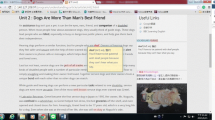Abstract
This is a descriptive account of the development of a hypertext computer program to enhance the scientific writing skills of upper secondary physics students. The program facilitates the integration of concept mapping, inferential reading, student-teacher dialogue, models of writing in the scientific register and the clear display of assessment criteria. This was achieved by the design and use of a program called ‘HyperCardPhysics’ (HCP) for Apple-Macintosh computers. It has been tried out in a number of schools in South Australia with positive results.
Similar content being viewed by others
References
Bereiter, C., & Scardamalia, M. (1987).The psychology of written composition. Hillsdale, NJ: Lawrence Erlbaum Associates.
Biggs, J. & Collis, K. (1982).Evaluating the quality of learning. The SOLO taxonomy New York: Academic Press.
Collier, G. H. (1989). Thoth-11 hypertext with explicit semantics. InHypertext '87 Proceedings (pp. 269–290). New York: Association for Computing Machinery Inc.
Cronin, P., Brown, L. & Pollard, J. (1993). An assessment scheme for upper secondary physics essays.Australian Science Teachers Journal. (in press).
Derewianka, B. (1990).Exploring how texts work. Rozelle, NSW: Primary English Teachers Association.
Gilbert, P. (1991). Shifting parameters of writing research: Writing as social practice.Australian Journal of Reading, 14(2), 96–102.
Gilding, K. R. (1988).South Australian enquiry into immediate post-compulsory education. Adelaide: Education Department of South Australia.
Gilding, K. R. (1989).Second report of the enquiry into immediate post-compulsory education. Adelaide: Education Department of South Australia.
hardy, J. & Klarwein, D. (1990)Written genres in the secondary school. Cairns: Peninsula Region Resource Centre Department of Education Queensland.
Hartley, J. (1993). Writing, thinking and computers.British Journal of Education Technology, 24(1), 22–31.
Hewitt, P. (1987).Conceptual physics. Menlo Park, CA: Addison-Wesley.
Lemke, J. L. (1990)Talking science: Language, learning and values. Norwood, NJ: Ablex Publication Corporation.
Martin, J. (1990). Literacy in science: learning to handle text as technology. In F. Christie (Ed.),Literacy for a changing world. Hawthorn: Australian Council of Educational Research.
Neuwirth, C., Kaufer, D., Chimera, R. & Gillespie, T. (1989). InHypertext '87 Proceedings (pp. 121–141). New York: Association for Computing Machinery Inc.
Rothery, J. (1989). Exploring the written mode and the range of factual genres. In F. Christie (Ed.),Writing in schools: study quide. Geelong: Deakin University Press.
Smith, J. B., Weiss, S. F. & Ferguson, G. J. (1989). A hypertext writing environment and its cognitive basis. InHypertext '87 Proceedings (pp. 195–214). New York: Association for Computing Machinery Inc.
SSABSA. (1992).The SACE Writing Based Literacy Assessment. Adelaide: Senior Secondary Assessment Board of South Australia.
Author information
Authors and Affiliations
Additional information
Specializations: scientific literacy, writing in science, computers in science.
Specializations: student note taking in lectures, development and evaluation of computer programs to facilitate the learning of Chemistry.
Specializations: affective aspects of science and technology education.
Rights and permissions
About this article
Cite this article
Cronin, P., Williams, G. & Rennie, L. Development of a hypertext computer program to enhance the scientific writing of upper secondary physics students. Research in Science Education 23, 42–50 (1993). https://doi.org/10.1007/BF02357043
Issue Date:
DOI: https://doi.org/10.1007/BF02357043




